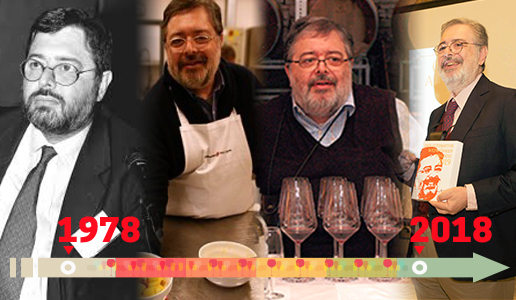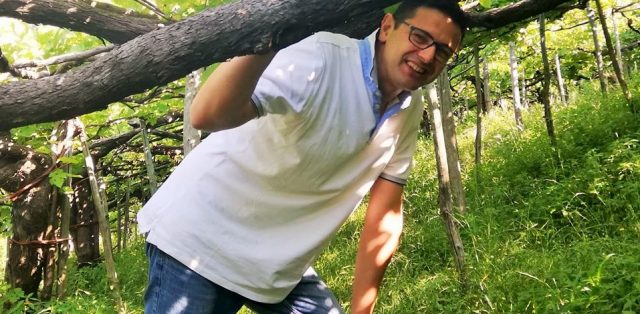My first 40 years of wine

Forty years ago, Daniele Cernilli took his first steps in the world of wine thus making him an eyewitness of the evolution of Italy’s wine history.
The title is inspired by that of the autobiography if Marina Ripa di Meana, who I fondly remember a year after her passing, and I use it to offer some memories and considerations of this by now long journey I have had in the world of wine. In fact, at the end of 2018 I will mark 40 years of wine.
My first membership card from the Italian Sommeliers’ Association (AIS) and the first wine course I took date back to 1979 but curiosity had already begun to draw me towards the mysteries of wine and so celebrating 40 years is more than justified. The stage for my first “practices” in wine tasting were Rome’s first wine bars: Cul de Sac in Piazza Pasquino and Cavour 313 on Via Cavour. Then there were the restaurants Severino in Piazza Zama and Checchino dal 1887in Testaccio. I also read magazines like Vini & Liquori, directed by Luigi Veronelli, which no longer exists, and Civiltà del Bere, which still exists and, if possible, is more interesting than ever.
It was a pioneering time for quality wines with relatively few producers making them and certain areas were just beginning to come into their own. In Montalcino, for example, there were some 20 wineries whereas today there are over 200. In Franciacorta, there were only four or five wineries while there were more in the Langhe where the Barolo Boys still had make a name for themselves. There wasn’t much available information-wise and Veronelli was the only one who could be considered an “opinion-maker” in that sector.
There was a lot of unbottled bulk wine, many white wines were unwittingly orange wines, especially in central-southern Italy, and the wine experts with degrees from the Institute for Experimental Winemaking in Conegliano were just beginning to work with musts throughout the country. Livio Jannattoni, a great writer about things involving Rome and consumer of bulk Castelli Romani wines, lashed out against the “modernist” trends in winemaking. I wrote an article, one of my first, for a Friuli magazine, Il Vino directed by Isi Benini, dedicated to the Marino Colle Picchioni wine of Paolo di Mauro, which was still orange having macerated in the skins, and almost got lynched for it. Tradition and modernity were subject to debate but in a much heavier way than today. This is how it was back them.
Milan was at the center of the world of Italian wine, with its big wine shops, Solci above all, with Marchesi and Santin, with Veronelli, the AIS of Marchi and Piccinardi and its legendary president Franco Colombani. We Romans were a small gang of trailblazing and somewhat naïve wine lovers. In Tuscany, Piero Antinori was revamping Chianti, Maurizio Zanella was inventing Franciacorta, which was still called “spumante”, and Angelo Gaja, Giacomo Bologna and Bruno Giacosa were Piedmont’s shining stars. Mario Schiopetto and Vittorio Puiatti, diehard rivals, were the champions of Friuli wines, along with Livio and Marco Felluga. Silvio Jermann had just come out with his Vintage Tunina which overturned the concept of varietal white wines but brought back a more authentic Collio tradition.
South of Tuscany, not much was going on; Edoardo Valentini, Emidio Pepe, the Leone de Castris and Mastroberardino families being exceptions. In Sicilia, there was Tasca d’Almerita, launched by a man who died too young many years ago, Ignazio Miceli, one of the most brilliant minds in the world of wine at the time. Marco De Bartoli was in an improbable quest to get his Vecchio Sampieri its just due and all we “young” wine lovers were his avid fans.
All this 40 years ago.
Much has happened since then. From the methanol scandal to the creation of Gambero Rosso, Slow Food and various wine guides, the mass exodus of sommeliers, the crisis in the publishing sector, Internet, websites and online sales and the advent of celebrity chefs, who seem to spend more time on TV than in the kitchen.
There are 20 times more wine producers today than 40 years ago and many areas have become very famous: Alto Adige, Etna, Bolgheri and Montefalco to name a few. Productive philosophies have become the subject of debate and sometimes even market strategies. There has been the rise and fall of using barriques. And maintaining control of estates and production has become more difficult. Today it is easier to take sides, to be a supporter of this or that approach, to join a wine tribe with strong convictions. But in the end, can’t that be said of what is happening in other fields? Is it just a sign of the times?
After all these years maybe there is something that I have understood. Sometimes, maybe the world of wine considers itself to be too specific, limited, and risks becoming self-referential. Instead, it is not a world apart, it lives and is subject to and interacts with the rest of the world, reality. And this is a challenge that must be taken up and tackled or risk being misunderstood by a public that has no desire to be caught up in technical meanderings and esoteric philosophies. To make oneself understood and appreciated with a certain carefreeness is and will be fundamental. Divulgation is and will be evermore important than organoleptic considerations, sharing is and will be decisive. These are things to keep in mind for the wine of the future and for my next 40 years.

 Italiano
Italiano








